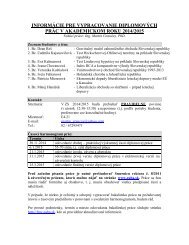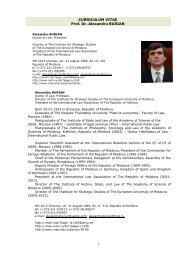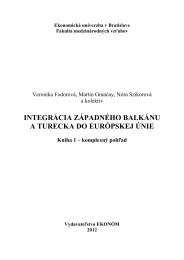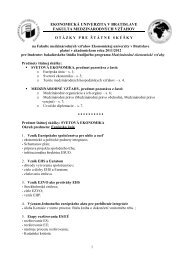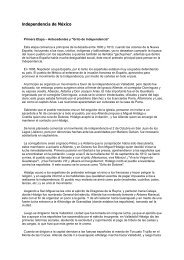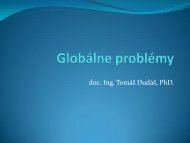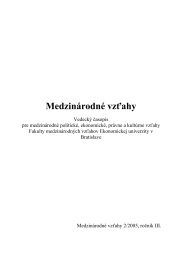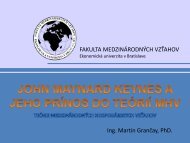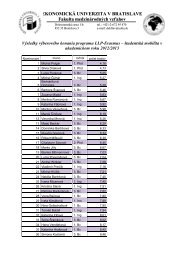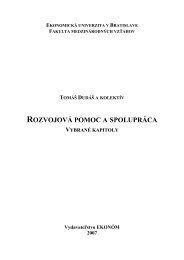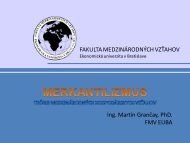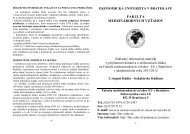4 - Fakulta medzinárodných vzťahov - Ekonomická univerzita v ...
4 - Fakulta medzinárodných vzťahov - Ekonomická univerzita v ...
4 - Fakulta medzinárodných vzťahov - Ekonomická univerzita v ...
You also want an ePaper? Increase the reach of your titles
YUMPU automatically turns print PDFs into web optimized ePapers that Google loves.
espect for ordinary citizens of the ENP countries and must be less tolerant or permissive ofauthoritarian regimes. Societies rather than governments should be in the center of its attention.The program of Eastern Partnership should be made more attractive for the partnercountries themselves. In order to reach this goal all NGOs must be treated as institutionalpartners of the EU. A bottom-up approach should also strengthen a need for reform in someEaP countries through social pressure on governments. Finally, a greater support and interest ofeastern partners themselves are required. They would be very helpful for a more effectiverealization of the whole program.REFERENCES:1. Council of Ministers, (2012): Polish Presidency of the Council of the European Union1 July - 31 December 2011. Final Report preparations, achievements, conclusions,Warsaw, Ministry of Foreign Affairs Republic of Poland, pp. 246.2. Eastern Partnership Civil Society Forum, (2011): Survey of Current and PlannedProjects Focusing on Eastern Partnership Issues: Summary prepared by EaP CSFSteering Committee, 20 May, [cited 28.08.2012], available online: .3. European Commission, (2011): Additional funding allocated to the NeighbourhoodInvestment Facility to support key investment projects, [cited 25.08.2012], availableonline:.4. European Commission, (2011): A Budget for Europe 2020, Brussels, 29.6.2011,COM(2011) 500 final, [cited 25.08.2012], available online:.5. High Representative of the European Union for Foreign Affairs and Security Policy,(2011): Implementation of the European Neighbourhood Policy in 2010. Report:Eastern Partnership, Brussels, Joint Staff Working Paper 25.05., sec(2011) 641, [cited28.08.2012], available online: .6. Inauguration of the Eastern Partnership Academy of Public Administration, (2011):Warsaw 4.11.2011; [cited 28.08.2012], available online:.7. Kaczyński, P. M. (2011): Polish Council Presidency 2011. Ambitions and Limitations,Swedish Institute for European Policy Studies, Stockholm, pp.76. ISBN 91-85129-85-2.8. Lada, A. (2011): Towards a stronger role for civil society in the Eastern Partnership,Policy Brief, European Policy Center, Brussels, July, pp. 4.9. Longhurst, K., Wojna, B., (2011): Asserting the EU's Mission in the Neighbourhood:Ten Recommendations for an effective Eastern Partnership, Report of the PolishInstitute of International Affairs, Warsaw, pp. 24. ISBN 978-83-62453-24-5.10. Ministry of Foreign Affairs, (2011): Programme of the Polish Presidency of theCouncil of European Union 1 July 2011 – 31 December 2011, Warsaw, pp. 38.11. Ochmann, C. (2012): The New EU. The Consequences of the Polish EU Presidency,Bertelsmann Stiftung, Spotlight Europe, January, pp. 6.12. The Role of the Eastern Partnership Civil Society Forum, (2011): [cited 28.08.2012],available online: < www.eap-csf.eu/en/about-eap- csf/our-role.>13. Saryusz-Wolski, J. (2011): Non-paper on the European Neighbourhood Policy'sEastern dimension, Europe’s World, 30.05., pp. 8.MEDZINÁRODNÉ VZŤAHY, 2012, 4 ○ 127



